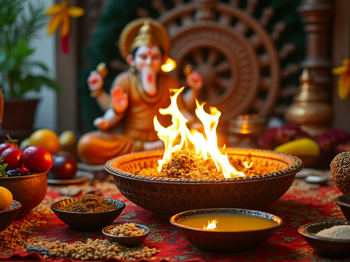



Grah Pravesh Puja & Havan is a deeply spiritual and auspicious Hindu ritual performed when one enters a new home for the first time. The term "Grah Pravesh" translates to "entering the house," and this ceremony marks the formal beginning of living in a new residence. It is believed that conducting this ritual purifies the home, drives away negative energies, and invites peace, prosperity, and happiness into the lives of the inhabitants. The ceremony typically involves a Puja (worship) and Havan (a fire ritual) dedicated to various deities, especially Lord Ganesha, who is revered as the remover of obstacles, and Vastu Purush, the deity associated with the home’s architecture and energies.

The significance of Grah Pravesh Puja & Havan lies in its profound spiritual and cultural meaning. The ritual is rooted in the belief that the environment of a home can influence the well-being of those living in it. By performing this Puja and Havan, it is believed that the home is blessed, sanctified, and harmonized with positive energies, ensuring that the residents experience peace and prosperity. The chanting of Vedic mantras and the offering of sacred items into the fire during the Havan are intended to please the deities and the natural elements, securing their blessings for the household.
Purification of Space: The rituals help cleanse the home of any negative energies or past influences that might affect the new occupants.
Harmonization with Natural Forces: The Puja and Havan align the home with positive cosmic energies, ensuring a harmonious environment.
Spiritual Protection: The ceremonies are believed to provide spiritual protection to the home and its residents, guarding against evil forces and misfortune.
Prosperity and Success: Invoking blessings from deities like Lord Ganesha and Vastu Purush is thought to bring prosperity, success, and good fortune to the household.
Health and Well-being: The rituals are said to promote physical and mental well-being by creating a serene and peaceful atmosphere in the home.
Strengthening Family Bonds: The collective participation in the Puja fosters unity and strengthens bonds among family members as they embark on a new chapter together.
Satisfaction and Peace of Mind: Performing the Grah Pravesh Puja provides a sense of satisfaction and peace of mind, knowing that the home has been consecrated and blessed according to ancient traditions.
Performing a Grah Pravesh Puja (housewarming ceremony) and Havan (sacred fire ritual) is an important tradition in Hindu culture to bless a new home. The ceremony is believed to bring peace, prosperity, and positive energy into the house. Here's a step-by-step guide to performing the Grah Pravesh Puja and Havan:
Choose an Auspicious Date (Muhurat):
Clean and Decorate the House:
Gather the Required Items:
Invite a Priest:
Sprinkling Holy Water:
Breaking a Coconut:
Boiling Milk:
Distribute Prasad:
Housewarming Meal:
This step-by-step guide ensures that the Grah Pravesh Puja and Havan are performed with devotion, bringing peace, prosperity, and happiness to your new home.